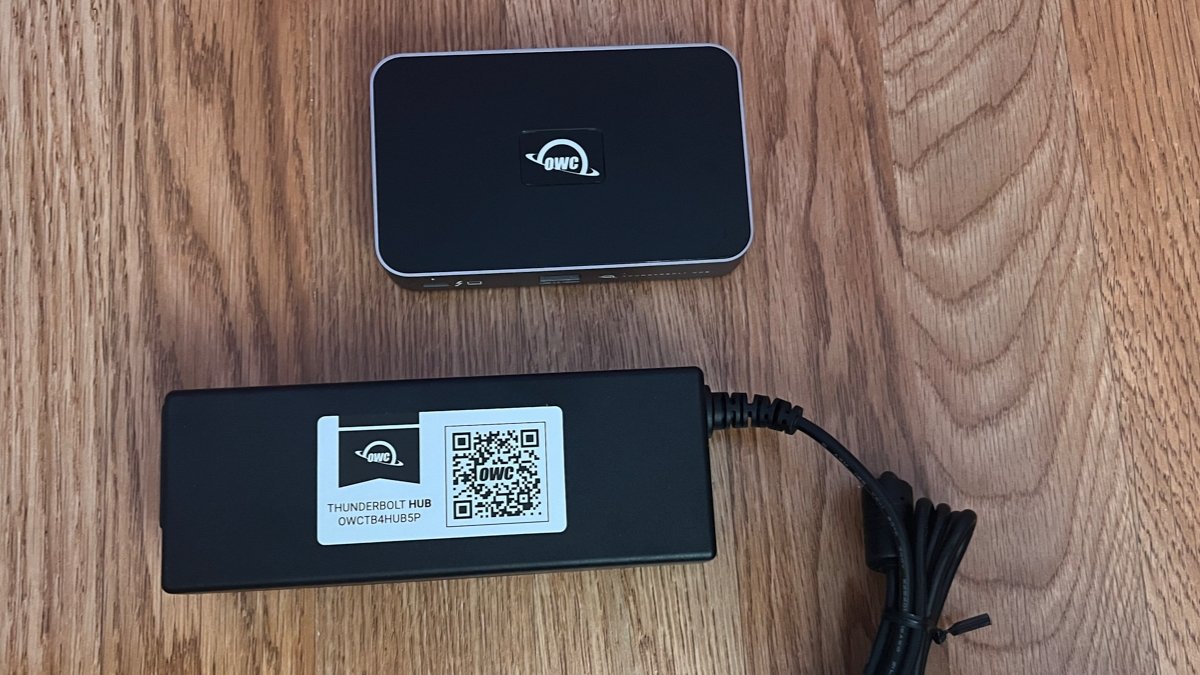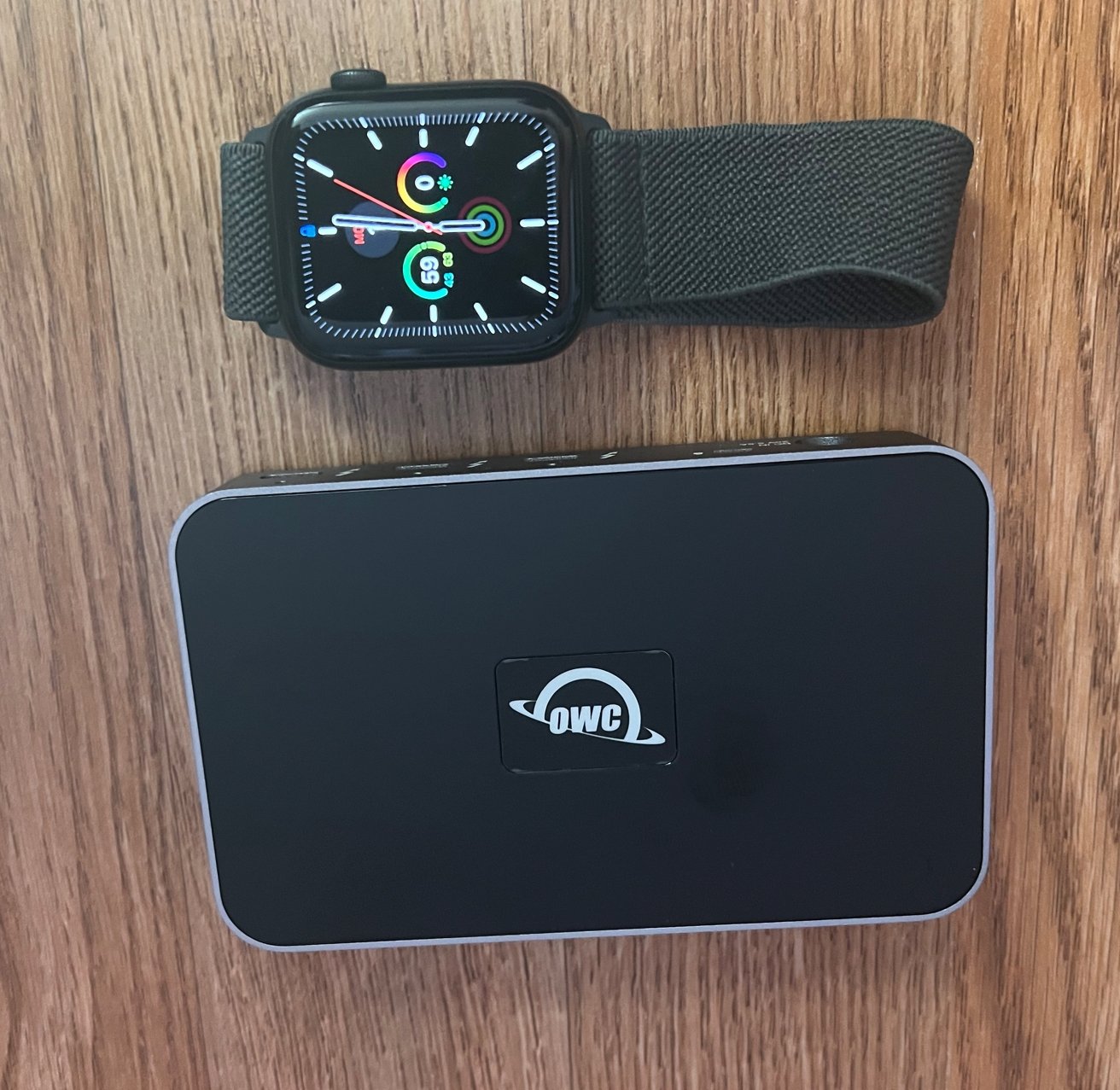OWC's Thunderbolt Hub is the world's first dock that will give you more Thunderbolt 3 or 4 ports than it occupies on your MacBook Pro, but it's not for everybody.

There are many docks on the market that offer ways to add more ports to the usually port-constrained MacBook Air and MacBook Pro. Along with offering more ports to use than Apple supplies in its products, docks and hubs provide display and peripheral connectivity to a host Mac through a single cable, one that even offers a way to power the Mac too.
A "normal" Thunderbolt dock connects through one of a Mac's Thunderbolt ports and provides access to a plethora of other types of ports that for the most part on its portable line, Apple has not seen fit to include. With the OWC Thunderbolt Dock, the focus is on Thunderbolt, with the port on the front intended for the host Mac, and the three on the other side for Thunderbolt connectivity to peripherals and the like.

It's not all Thunderbolt, as there is one single USB-A 3.2 connection along for the ride, as well as the obligatory power-in port, Kensington Nano slot, and indicator LEDs. All this is housed in an aluminum and plastic housing that's 4.6 inches long, 2.9 inches wide, 0.7 inches thick, and 7.3 ounces in weight.
The case top gets a little hot in use, but it's not terrible. Using a non-contact thermometer, we saw temperatures of about 45C in a 20C ambient room. Warm, but not hot to the touch. The OWC logo is a bit bright, but this is solvable with a bit of electrical tape.
Honestly, there's not a huge amount of technical assessment needed here. I tried the OWC Thunderbolt hub on an assortment of machines, ranging back to a 2016 MacBook Pro. The long and the short of it is, as long as the machine is running Big Sur or newer, this simple box will give you three Thunderbolt 3 ports and a USB-A port in the place of one Thunderbolt 3 or Thunderbolt 4 port.
Wait, a hub that provides multiple Thunderbolt 3 ports?
Typically, Thunderbolt relies on daisy-chaining, one device after another, occupying just one Thunderbolt port on the host Mac. The problem with this situation is that if you disconnect a device in the middle of the chain, you break the chain for further-away devices, which will remain disconnected until they rejoin the chain.
The OWC Thunderbolt Hub beats this limitation by allowing users to create separate "tree branch" chains. In effect, you can remove one of the three branches by disconnecting it from the hub, without impacting devices connected to either of the two remaining Thunderbolt ports.
And, you can still daisy-chain devices downstream, if you're loaded with Thunderbolt or USB-C peripherals.
OWC also reasons that this could be beneficial to users of multiple drives. In a usual chain, drives are recommended to be as close to the host as possible, to maximize the amount of data it has access to without being impacted by other devices. Meanwhile, bus-powered drive use is limited as you have to put them last on the chain and are limited to one per chain.
With the hub, it means users could connect up to three bus-powered Thunderbolt drives at the same time, all to one single port on the host.
The entire chain is still bandwidth-limited to 40 gigabits per second, with no one device taking more than 32 gigabits per second -- but that's fine. If you're doing just about anything short of dual eGPUs or data transfers between two NVMe-based SSDs, you're realistically not going to hit that often, if at all.
OWC Thunderbolt Hub - display and peripheral support
With Thunderbolt's ability to handle video, you can obviously connect monitors to the Thunderbolt Hub. It is capable of supporting a single 8K or 5K display at up to 60Hz, one 4K display at 120Hz, or two 4K displays at 60Hz assuming the host can handle it. We tested two 4K displays at 60Hz on a 2018 Intel Mac mini, and on a 16-inch M1 Max MacBook Pro with a USB-C to HDMI cable and a USB-C to DisplayPort cable and had no issues.
In the event your host device doesn't have Thunderbolt available, such as a PC with USB-C, you could still use the hub with it, but you will be limited to a maximum bandwidth of up to 10Gb/s through USB-C -- which is fine, and more than enough for even an eight hard drive array per port.
To ensure it works perfectly with your Mac, OWC includes software like the OWC Dock Ejector, for safely disconnecting multiple drives connected to the hub by making sure that all data writes are completed beforehand. There's also a driver for that app that enables rare support for the Apple SuperDrive with the hub's USB-A port.
OWC Thunderbolt Hub - power considerations
You do get power delivery to a host device with the hub, with it providing up to 60 watts of charging power. This is certainly adequate enough for a 13-inch MacBook Pro or a MacBook Air, or even older Intel models, but it doesn't quite seem enough.
We'd like it to provide 87W of power to the host device, to support a larger MacBook Pro a little better, though. That said, it drives a 14-inch MacBook Pro with M1 Pro processor just fine, and under massive load, the battery will slowly drain.
We don't recommend using it with the 16-inch MacBook Pro as a power supply, just because of the screen's extra power demands. Under little load with the new 16-inch MacBook Pro, the battery will charge, albeit slowly.
Under any meaningful load at all, the battery will drain about 3% per hour. Better than nothing, but not what you'd call ideal.
Why did you buy this?
My own use for this is as an ersatz Thunderbolt extender. My Mac mini server is underneath the plane of a desk, sitting on top of a Thunderbolt RAID enclosure for mass storage. We're using it to bring the connection "topside" as it were.
So, in this case, we'd prefer the Thunderbolt host connect on the opposite side of the dock, instead of having to wrap the power cable around to the back. This isn't a big deal, and is probably just fine for most users, as the USB-A stuff is the generally the routinely swapped devices, and the Thunderbolt 3 stuff is the permanent plugs.
The 60W power limitation isn't a big deal for this use case. But, I also assume that folks extending like this may need more and different ports.
Targeted product for specific needs
You'd think at this point, I'd be hip-deep in Thunderbolt docks. The reality is, nearly everything we review are loaned to us for the review by the vendor, and returned shortly thereafter.
So for our personal projects, like my continued Mac mini-based home server effort, we buy our own gear. And, the OWC Thunderbolt hub is no exception.
OWC has answered the problem of limited Thunderbolt ports on the first round of M1 Macs, as well as giving users more choice in how they connect Thunderbolt hardware. For owners of MacBooks that don't need a lot of power and want a basic dock with power delivery for a single-cable connection, the OWC Thunderbolt Hub could be a viable solution.
The slightly lacking power delivery may not be the best for more powerful MacBook Pro owners, who will need to add more power through other means. But the extra Thunderbolt connectivity it provides still makes it attractive to the right user.
This isn't for everybody. But for the few workflows that need multiple Thunderbolt ports in a tree downstream of a single port on the host machine, it fits that niche perfectly.
The all-mighty Google demands a score, and this product a hard one to assign a universal score to. It will be of little use for most folks, and the $179 retail price for it is better spent on a USB 3.2 Type C dock, or a Thunderbolt dock with more legacy ports.
For folks that just need a dock and don't need a pile of Thunderbolt, there are better options, and this is a 2 out of 5.
But, if you need more Thunderbolt, it's the only game in town that's actively shipping right now -- but the 60W is baffling. This isn't a consumer-centric product, and the "pro" market probably needs more power. For that market, this is a 4 out of 5 product, only hampered by the 60W power delivery.
Score: 3.5 out of 5
Pros
- More Thunderbolt!
- Bundled software protects your data
- Expensive for what ports you get beyond Thunderbolt
- Case gets hot - we'll be watching this over time
- Not enough host power
Where to buy
At press time, the OWC Thunderbolt Hub is available directly from OWC for $179.99. It periodically shows up in their about monthly garage sales for a bit less open box.